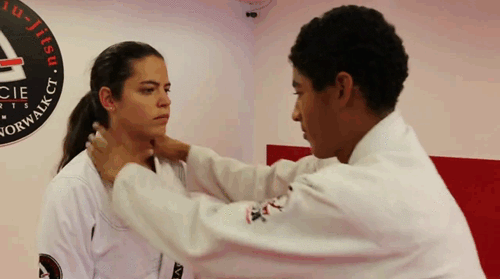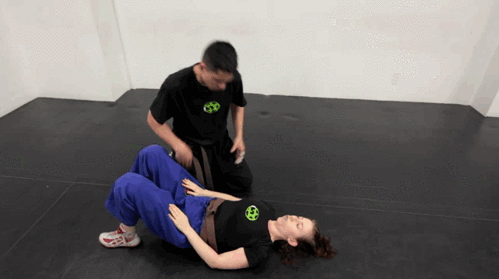Festo’s Bionic Flying Fox, As An Example Of Bio-mimicry.
Festo’s Bionic Flying Fox, as an example of Bio-mimicry.
German automation company Festo has created a Flying Fox (Fruit Bat) made of a 580g foam body with a carbon fibre skeleton and a membrane like material for the wings.
This robot imitates the exact body and wing movements of an actual bad in order for it to fly. This idea of bio-mimicry is one that is paving the way for a host of natural moving, nature inspired machines.
More Posts from Study-astronomy-biology-ref and Others

Three galaxies at once
Rising majestically above the telescopes of ESO’s La Silla Observatory in Chile we see the Milky Way accompanied by its two dwarf neighbour galaxies, the Large and Small Magellanic Clouds.
Credit: ESO/A. Santerne









How to Escape a Hair Grab or a Neck Grab ? Look at them, carefully.
tai chi pants on http://www.icnbuys.com/tai-chi-pants give you surprise at the new year.
follow back
is there anything you can tell us to expand on the space time ripples found in simulated black hole collisions?
Hi!
In one of my other responses I explained the whole concept of space time, here’s how i explained that:
A way that you can picture the bending of space time is this:
Picture two chairs, the backs facing each other. Then tape one end of a blanket to one of the chair backs and the other end of the blanket to the other chair back. What you have now should like this:

Now, if you were to place a tennis ball somewhere on the light blue blanket (top blanket), that blanket would no longer be flat, there would be a bend or a curve in it. Let’s say you put a basketball on the top blanket instead of a tennis ball. Since the basketball is bigger, the bend/curve that it makes will be a lot bigger than the tennis ball’s because the basketball has more mass.
So that blue blanket at the top of the chairs represents space time. If there were to be two large objects, let’s say basketballs, that were to “collide” (representing two black holes). Since they’re so large, they’d create these ripples in the blanket that can be observed.
Another easier way to think about it is like dropping a pebble into a lake. The bigger the pebble, the stronger and more frequent the ripples are. So since black holes are very massive, they create larger ripples compared to something smaller!
Astronomers haven’t been able to directly observe these ripples in space time, they were theorized by Einstein, however there’s an announcement being made all over the world today about data obtained from the Laser Interferometer Gravitational-Wave Observatory (LIGO)!
Here is a link talking a bit about that press conference!
I hope that helped to clarify everything! If not, feel free to ask again and I’ll try my best to clarify!
UPDATE: HERE are the findings of the conference, they’ve detected them for the first time!
Use studying techniques to your advantage:
Got these notebooks for 5 cents so obviously going to buy more than one :D # strongnotebookgameisstrong

There’s a method to my madness I swear!! OK so on avg I seem to use up two of those 80 pg notebooks so I got two for each class. And consequently I needed the 4pack 32pg exercise books.

The 80 page notebook is used for in class notes. As soon as anything important is said it is scribbled down into the notebook. The 4 pack 32 pg exercise book is divided to two groups: Feymann technique and Cornell method.
Feymann Technique
Right after class I grab my textbook, my notebooks and two of my exercise books. I teach myself the lesson primarily with my notes and if I don’t understand something I turn to my textbook. If I am still lost I leave space and note that there is something I need to clarify with my professor. Even while I am doing this, I force myself to decrease the writing and increase the connections between every topic since the 32 pg is quite smaller than the 80 pg.
Thankfully when I am done with this, my 32pg becomes the go to whenever it seems like I am in need of revising a topic since it contains relevant notes from both my textbook and my notebook in my own words.
Cornell Method.
When exam time approaches I convert my notes into the cornell notes so that I can easily test myself with the main ideas and key questions.
There is no better way to revise than to try to make connections. That is all you are going to get tested on since it’s not that hard to spit back words on a page. Instead of being asked about photosynthesis for example, you might be told about some chemical that is sprayed on a plant that will block one process and asked about how that affects the growth of the plant overall. See what I mean?

I usually get a whiteboard and write all of the connections out and in front of me. When THAT is done I write it down in flashcard mode and quiz myself for the next week using the Leitner system, along with the topics that are basically just memorization.
LEITNER SYSTEM

Label 5 boxes 1-4, where 1 is for cards you don’t know and 4 is for cards you are basically a pro in. You frequently test yourself in box 1 (maybe every 30 mins, you choose) and increase the time in which you test yourself until you reach 4, where you would test yourself just once a day.
In the beginning all of your cards go in box 1,and as you get a card right it goes up a level and if you get it wrong it goes down a level. That way you are spending more time with ideas and topics you don’t have a strong hold on, rather than spending equal time with all the topics.
At this point I have rewritten my notes twice in my own words and then converted them into flashcard mode :) I recommend this method when it comes to the sciences or humanities. For the maths I have already done a post about it here.
Hope this helps for those still looking for study techniques!
-F










This Year in Space (infographic)
From Pluto to the most Earth-like planet ever discovered…this years was a fantastic year in space. Here are the most notable astronomical events from 2015.
May you all journey well into 2016.
See all our infographics at: http://futurism.com/infographics/
Largest Batch of Earth-size, Habitable Zone Planets
Our Spitzer Space Telescope has revealed the first known system of seven Earth-size planets around a single star. Three of these planets are firmly located in an area called the habitable zone, where liquid water is most likely to exist on a rocky planet.

This exoplanet system is called TRAPPIST-1, named for The Transiting Planets and Planetesimals Small Telescope (TRAPPIST) in Chile. In May 2016, researchers using TRAPPIST announced they had discovered three planets in the system.

Assisted by several ground-based telescopes, Spitzer confirmed the existence of two of these planets and discovered five additional ones, increasing the number of known planets in the system to seven.

This is the FIRST time three terrestrial planets have been found in the habitable zone of a star, and this is the FIRST time we have been able to measure both the masses and the radius for habitable zone Earth-sized planets.
All of these seven planets could have liquid water, key to life as we know it, under the right atmospheric conditions, but the chances are highest with the three in the habitable zone.

At about 40 light-years (235 trillion miles) from Earth, the system of planets is relatively close to us, in the constellation Aquarius. Because they are located outside of our solar system, these planets are scientifically known as exoplanets. To clarify, exoplanets are planets outside our solar system that orbit a sun-like star.

In this animation, you can see the planets orbiting the star, with the green area representing the famous habitable zone, defined as the range of distance to the star for which an Earth-like planet is the most likely to harbor abundant liquid water on its surface. Planets e, f and g fall in the habitable zone of the star.
Using Spitzer data, the team precisely measured the sizes of the seven planets and developed first estimates of the masses of six of them. The mass of the seventh and farthest exoplanet has not yet been estimated.

For comparison…if our sun was the size of a basketball, the TRAPPIST-1 star would be the size of a golf ball.
Based on their densities, all of the TRAPPIST-1 planets are likely to be rocky. Further observations will not only help determine whether they are rich in water, but also possibly reveal whether any could have liquid water on their surfaces.
The sun at the center of this system is classified as an ultra-cool dwarf and is so cool that liquid water could survive on planets orbiting very close to it, closer than is possible on planets in our solar system. All seven of the TRAPPIST-1 planetary orbits are closer to their host star than Mercury is to our sun.

The planets also are very close to each other. How close? Well, if a person was standing on one of the planet’s surface, they could gaze up and potentially see geological features or clouds of neighboring worlds, which would sometimes appear larger than the moon in Earth’s sky.

The planets may also be tidally-locked to their star, which means the same side of the planet is always facing the star, therefore each side is either perpetual day or night. This could mean they have weather patterns totally unlike those on Earth, such as strong wind blowing from the day side to the night side, and extreme temperature changes.

Because most TRAPPIST-1 planets are likely to be rocky, and they are very close to one another, scientists view the Galilean moons of Jupiter – lo, Europa, Callisto, Ganymede – as good comparisons in our solar system. All of these moons are also tidally locked to Jupiter. The TRAPPIST-1 star is only slightly wider than Jupiter, yet much warmer.
How Did the Spitzer Space Telescope Detect this System?
Spitzer, an infrared telescope that trails Earth as it orbits the sun, was well-suited for studying TRAPPIST-1 because the star glows brightest in infrared light, whose wavelengths are longer than the eye can see. Spitzer is uniquely positioned in its orbit to observe enough crossing (aka transits) of the planets in front of the host star to reveal the complex architecture of the system.

Every time a planet passes by, or transits, a star, it blocks out some light. Spitzer measured the dips in light and based on how big the dip, you can determine the size of the planet. The timing of the transits tells you how long it takes for the planet to orbit the star.

The TRAPPIST-1 system provides one of the best opportunities in the next decade to study the atmospheres around Earth-size planets. Spitzer, Hubble and Kepler will help astronomers plan for follow-up studies using our upcoming James Webb Space Telescope, launching in 2018. With much greater sensitivity, Webb will be able to detect the chemical fingerprints of water, methane, oxygen, ozone and other components of a planet’s atmosphere.
At 40 light-years away, humans won’t be visiting this system in person anytime soon…that said…this poster can help us imagine what it would be like:

Make sure to follow us on Tumblr for your regular dose of space: http://nasa.tumblr.com

If someone is attractive and charming, you’re more likely to assume they’re intelligent and hard working- even if they’re not.
Known as the ‘Halo Effect’, it’s a theory that our generalized judgements of people can bleed over into the more specific judgements we make about them. Studies show that even though we understand the Halo Effect intellectually, it’s almost impossible for us to recognize when it’s actually happening.
(Source, Source 2)









Cosmic Web
The concept of the cosmic web—viewing the universe as a set of discrete galaxies held together by gravity—is deeply ingrained in cosmology. Yet, little is known about architecture of this network or its characteristics. Our research used data from 24,000 galaxies to construct multiple models of the cosmic web, offering complex blueprints for how galaxies fit together. These three interactive visualizations help us imagine the cosmic web, show us differences between the models, and give us insight into the fundamental structure of the universe.
An awesome work of the Center for Complex Network Research
It’s Pi Day!
Pi Day, the informal holiday beloved by math enthusiasts — and even by the math averse — is here! March 14 marks the yearly celebration of the mathematical constant π (pi).

What is Pi?
Pi (3.1415….) is the ratio of circumference to diameter in a circle. Any time you want to find out the distance around a circle when you have the distance across it, you will need this formula.
Despite its frequent appearance in math and science, you can’t write pi as a simple fraction or calculate it by dividing two integers. For this reason, pi is said to be “irrational.” Pi’s digits extend infinitely and without any pattern, adding to its intrigue and mystery.
How Do We Use Pi at NASA?

Measurements: Pi can be used to make measurements – like perimeter, area and volume.
For example, sometimes we use lasers to explode ice samples and study their composition. In this scenario, we can uses pi to calculate the width of the laser beam, which in turn can be used to calculate the amount of energy, or fluence, that hits the ice sample. A larger fluence equals a bigger explosion in the ice.

Commanding Rovers: Pi is also used every day commanding rovers on the Red Planet. Everything from taking images, turning the wheels, driving around, operating the robotic arm and even talking to Earth!
Make sure to follow us on Tumblr for your regular dose of space: http://nasa.tumblr.com

Would It Be A Bad Thing to Wipe Out A Species … If It’s A Mosquito?
Mosquitoes have a nasty reputation.
The species Aedes aegypti, for example, is currently responsible for spreading the Zika virus through the Americas and also infects humans with dengue fever, chikungunya and yellow fever.
This raises the question: Should there be an effort to get rid of Aedes aegypti for good?
“There’s been lots of debate in the last 10 years whether we should eradicate mosquitoes, or at least the 100 species or so that serve as disease vectors for humans,” says David Magnus, director of Stanford University’s Center for Biomedical Ethics. “If you look at the science, the majority [of scientists] think we could probably eliminate mosquitoes without too much harm on the environment.”
Read the full story here.
Illustration: Matthew Twombly
-
 ceintheworld liked this · 3 years ago
ceintheworld liked this · 3 years ago -
 smohsd-blog reblogged this · 3 years ago
smohsd-blog reblogged this · 3 years ago -
 thymsup reblogged this · 3 years ago
thymsup reblogged this · 3 years ago -
 novasfindings reblogged this · 4 years ago
novasfindings reblogged this · 4 years ago -
 littlejinx liked this · 4 years ago
littlejinx liked this · 4 years ago -
 itaiko liked this · 4 years ago
itaiko liked this · 4 years ago -
 anxight liked this · 4 years ago
anxight liked this · 4 years ago -
 shroudedhermit liked this · 4 years ago
shroudedhermit liked this · 4 years ago -
 h0pefully-helpful liked this · 4 years ago
h0pefully-helpful liked this · 4 years ago -
 cazzylimerence liked this · 4 years ago
cazzylimerence liked this · 4 years ago -
 ticktockat liked this · 4 years ago
ticktockat liked this · 4 years ago -
 robotrightsactivist liked this · 4 years ago
robotrightsactivist liked this · 4 years ago -
 aerial-trickster reblogged this · 4 years ago
aerial-trickster reblogged this · 4 years ago -
 noctivagusserpent liked this · 4 years ago
noctivagusserpent liked this · 4 years ago -
 kanelazar liked this · 4 years ago
kanelazar liked this · 4 years ago -
 sigma-100001 liked this · 4 years ago
sigma-100001 liked this · 4 years ago -
 maltedsoda liked this · 4 years ago
maltedsoda liked this · 4 years ago -
 eclipsisnevermore liked this · 4 years ago
eclipsisnevermore liked this · 4 years ago -
 mossear07 liked this · 4 years ago
mossear07 liked this · 4 years ago -
 bowseroppo liked this · 4 years ago
bowseroppo liked this · 4 years ago -
 skellingcrow reblogged this · 4 years ago
skellingcrow reblogged this · 4 years ago -
 anxvu reblogged this · 4 years ago
anxvu reblogged this · 4 years ago -
 anxvu liked this · 4 years ago
anxvu liked this · 4 years ago -
 insomniac-nerd-posts-things liked this · 4 years ago
insomniac-nerd-posts-things liked this · 4 years ago -
 sunshine-tattoo reblogged this · 4 years ago
sunshine-tattoo reblogged this · 4 years ago -
 sunshine-tattoo liked this · 4 years ago
sunshine-tattoo liked this · 4 years ago -
 silvergreyhalberd reblogged this · 4 years ago
silvergreyhalberd reblogged this · 4 years ago -
 vagrantviking69 liked this · 4 years ago
vagrantviking69 liked this · 4 years ago -
 missdragoon reblogged this · 4 years ago
missdragoon reblogged this · 4 years ago -
 missdragoon liked this · 4 years ago
missdragoon liked this · 4 years ago -
 reeandrea liked this · 4 years ago
reeandrea liked this · 4 years ago -
 bumblebeeappletree reblogged this · 4 years ago
bumblebeeappletree reblogged this · 4 years ago -
 bumblebeeappletree liked this · 4 years ago
bumblebeeappletree liked this · 4 years ago -
 docpiplup liked this · 4 years ago
docpiplup liked this · 4 years ago -
 9tailsmaki liked this · 5 years ago
9tailsmaki liked this · 5 years ago -
 idkaboutnames reblogged this · 5 years ago
idkaboutnames reblogged this · 5 years ago -
 idkaboutnames liked this · 5 years ago
idkaboutnames liked this · 5 years ago

This is a studyblr for everyone have some passion for science, especially astronomy and biology
129 posts